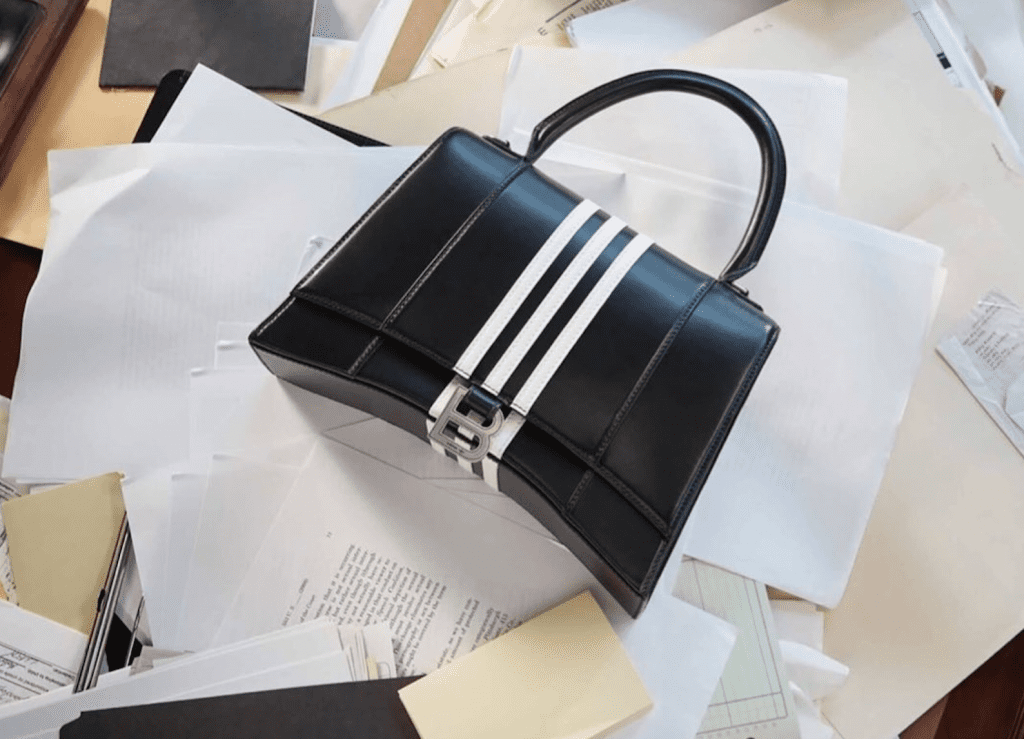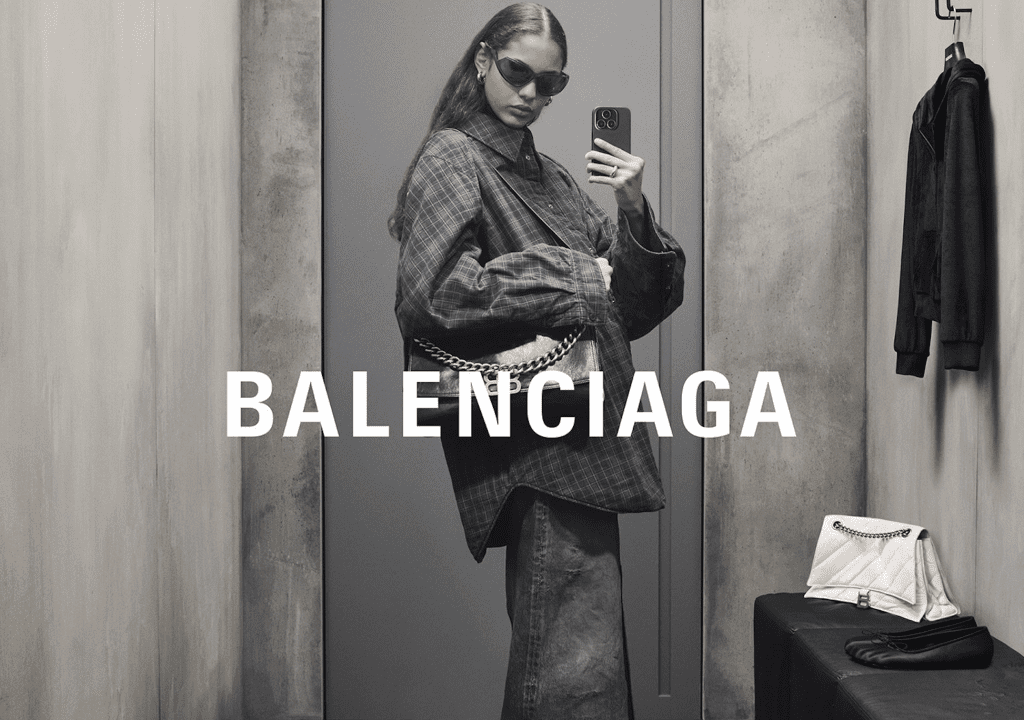Balenciaga is making headlines thanks to a towel. That is right, the French fashion brand – which is under the creative direction of Demna (the designer exclusively goes by his first name) – is garnering a whole lot of attention thanks to a wrap-around towel skirt that it is offering up for more than $900. In addition to prompting takes from the fashion media and generating consumer chatter on platforms like X, the terry cloth towel skirt – which is made in Italy, bears a relatively discrete Balenciaga logo (and two buttons), and is dry-clean only – has reached peak virality on TikTok, all of which has likely had a hand in sending Google searches for Balenciaga to a 90-day high last week.
Under the watch of Demna, Balenciaga has become well known for provoking by way of cultural commentary. This has taken the form of everything from runway shows, in which models, including the uber-controversial Kanye West, trudged through a runway of deep mud (a “metaphor for digging for truth and being down to earth,” per Demna) to $1,790 bags that closely mimic Hefty trash bags. Against that background, pushback over one or more of its offerings is hardly an untested avenue for Balenciaga. This time around, though, the pricey towel skirt and the attention that has garnered is noteworthy in that it seems to be an indication that almost exactly a year after a couple of ad campaigns brought Balenciaga to the brink of cancellation, the brand may be starting to find its footing again.
Ad Campaign Controversy
The controversy that proved to almost take down Balenciaga entirely in November 2022 stemmed directly from two ad campaigns – one in which child models were photographed holding “BDSM teddy bears” and a subsequent campaign (for S/S 2023), starring Bella Hadid, Isabelle Huppert, and Nicole Kidman, which saw a Balenciaga x adidas bag positioned on top of a pile of papers, including a page from the U.S. Supreme Court’s 2008 decision in U.S. v. Williams. That was a case that considered elements of the First Amendment in connection with a child-pornography conviction.

Taken together, the two campaigns prompted a level of consumer outrage that is rarely witnessed in the fashion industry. Consumers flooded the comments sections of Balenciaga’s social media pages to denounce the brand for “supporting pedophilia,” among other harsh words. Some called on Balenciaga-aligned celebrities, such as Kim Kardashian and Nicole Kidman, to cut ties with the company, others posted videos of themselves destroying Balenciaga wares on their social media accounts, and all the while, conspiracy theories, including from far-right-wing group, QAnon, abounded.
In an immediate attempt to address the situation, which escalated significantly over the matter of a few days in late November 2022, Balenciaga issued statements, which were largely viewed as an attempt by the brand to shift blame away from itself. Its American arm also initiated a short-lived lawsuit in a New York state court, in which it sought $25 million in damages from production company North Six and set designer Nicholas Des Jardins, who worked on the brand’s S/S 2023 campaign.
Nothing seemed to effectively quell the truly-enormous-amount of outrage that reached beyond the confines of fashion to make national (and international) news headlines until Balenciaga dropped the lawsuit, publicly condemned child abuse, and took full responsibility for the controversies in a statement on November 28. Even still, the ramifications of the campaigns and what was perceived as string of initial PR blunders ran deep. The company was forced to pull way back on advertising in certain markets, it fell from grace in relevant industry rankings, and its sales suffered.
Case in point: After climbing to the top of the Lyst’s influential Index of the fashion industry’s “hottest” brands in late 2021 and early 2022, Balenciaga fell from top to the number 11 spot in Q4 2022, with the fashion discovery platform citing the company’s “‘inappropriate’ campaign featuring children” as the reason for the unfavorable treatment. Balenciaga’s fall continued – with the brand dropping to the number 18 spot (of 20) for Q1 2023.
Balenciaga has further climbed up the Lyst Index, with the fashion discovery platform stating in its Q4 Index, “A year on from the controversy surrounding two campaigns, Balenciaga jumps a further two places up the Index into 12th position. In December, Balenciaga hosted its pre-Fall 24 show on a closed-down street in LA in front of guests including Kim Kardashian, Lil Wayne and Nicole Kidman. The event also served as a soft launch for a powerful collaboration with LA-based grocery store Erewhon: the capsule collection, which included a hoodie, t-shirt and tote bag with prices ranging from $425 to $1,150, quickly sold out and drove over 10.1 billion views on TikTok. Demand for Balenciaga products increased 7 percent on Lyst [in Q4], which begs the question: Can a fashion brand ever truly be ‘canceled’?”
Balenciaga’s woes could be seen in other metrics, as well. Its parent company, Kering, shed light on its financial woes in a number of financial filings from late 2022 and into this year. In stark contrast to the “momentum” that it was carrying into Q4 2022, thanks in large part to “higher penetration in Leather Goods … which [has] expanded in recent years and continued to attract new customers,” the ad campaign controversy prompted Balenciaga to experience declines towards to end of 2022. Kering stated in a 2022 Financial Document in February 2023 that “Balenciaga’s performance was outstanding for much of [2022], although the fourth quarter was less positive due to slower growth in certain markets and controversy regarding one of its media campaigns, particularly in the United States.”

Kering confirmed in an investor presentation this spring that Balenciaga – which was on track to break the €1 billion in sales mark back in 2019 – had a “challenging end of Q4, overshadowing a [otherwise] banner year” for the brand. Still yet, in its 2023 First-Half Report, Kering revealed that Balenciaga “continued to be affected in certain regions by the controversy in late 2022 relating to one of its advertising campaigns.” However, the impact of the controversy was not being uniformly felt, as its H1 revenue “grew in other markets, particularly in Asia,” a market that “was not affected by the late-2022 controversy.”
The Start of a Comeback
Fast forward to March 2023, and signs of a comeback for Balenciaga and its creative director Demna – who managed to remain in his role amid the fallout, as did CEO Cédric Charbit – seemed to be quietly coming about. In one of the earliest indications that a meaningful – and undoubtedly meticulously-crafted – rehabilitation effort was underway, the New Yorker published an interview with Demna, documenting in no truncated manner his utterly-unique approach to fashion/luxury and outlandishly-influential hold on the industry. For instance, “You have been dressed by Demna, at least indirectly, if you’ve recently worn a clunky sneaker or a humongous coat.”
The lengthy piece also sought to bring some humanity to the 41-year-old “supposed darklord of luxury fashion.” For instance, there was a bit about his upbringing: in Tbilisi, Georgia, “Demna wore hand-me-downs and castoffs. His parents economized by buying him clothes that would fit for several years;” about his personality: “he is a warm conversationalist, but describes himself as a loner, even ‘a loser;’” and what he does when he’s not designing: “when he is not making clothes, what he likes doing most is cooking.”
For his part, Demna explained himself (“I didn’t see the creepy part of it,” Demna said of the teddy bears. “But it’s obvious now.”) and expressed regret.
After a somewhat-self-imposed exile from the industry spotlight, as an i-D magazine piece put it recently, and in light of a dearth of any laudatory media attention for months on end, the New Yorker profile seemed a telling signal for what was to come for Demna and Balenciaga more broadly. All the while, Demna was also doing his part from a fashion perspective. In the wake of the scandal, he played it safe from a design perspective, paring things back (no controversy or PR stunts in sight) and focusing on design. “With this past week’s couture show in Paris, Demna continued to dig himself out of the mess using the only tool he has: inventive and covetable design,” the Wall Street Journal reported this summer.
Since then, the stigma appears to be fading. Balenciaga started its re-ascent of the Lyst Index this year – its nabbed the number 16 position in Q2 and 14 in Q3, with Lyst pointing to the brand’s recent enlisting of Isabelle Huppert and PP Krit Amnuaydechkorn as brand ambassadors, its haute couture show in Paris in July, and a Paris exhibition showcasing the archives of Cristóbal Balenciaga.
From a sales perspective, Kering does not break out figures for Balenciaga, but it noted in an investor presentation this month that while retail revenue for Balenciaga is “uneven” across regions, “APAC and Japan [were] performing well” in Q3. Those results follow from “gradual recovery” for the brand in Q2, which was also “driven by” the APAC region. There was no mention – for better or worse – of how it is doing in the West.
Elsewhere in the market, the brand is making headlines for things that are not related to the scandal. This month, for instance, Forbes called on readers to “applaud Balenciaga for selecting Michelle Yeoh – the first Asian to win an Oscar – as a brand ambassador.” And around the same time, Balenciaga garnered attention for “venturing into wearable tech with a new merchandise series that gives consumers exclusive access to media.”
The cherry on top here is, of course, the towel. The relatively light-hearted backlash over the terry cloth skirt – and the fact that Balenciaga released it in the first place, complete with its $925 price tag – seems to be an indication that it has started to find its footing again. As for whether it will regain some of the momentum it previously boasted in terms of revenue, that is yet to be seen. (Full year numbers from Kering will be telling.) If it does, it will not only have provided the industry with a case study in crisis communication (including what not to do) but also a playbook in how to make a comeback.
Updated
January 31, 2024
This article was initially published on November 29, 2023, and has been updated to reflect Balenciaga’s continued rise on Lyst’s quarterly ranking.











